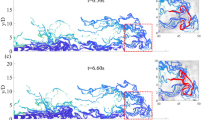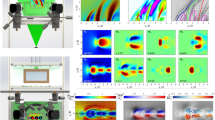Abstract
The digital particle image velocimetry (DPIV) technique has been used to investigate the flow fields of an elliptic jet in cross flow (EJICF). Two different jet orientations are considered; one with the major axis of the ellipse aligned with the cross flow (henceforth referred to as a low aspect ratio (AR) jet), and the other with the major axis normal to the cross flow (henceforth referred to as a high aspect ratio jet). Results show that the vortex-pairing phenomenon is prevalent in the low aspect ratio jet when the velocity ratio (VR)≥3, and is absent in the high aspect ratio jet regardless of the velocity ratio. The presence of vortex pairing leads to a substantial increase in the leading-edge peak vorticity compared to the lee-side vorticity, which suggests that vortex pairing may play an important role in the entrainment of ambient fluid into the jet body, at least in the near-field region. In the absence of vortex pairing, both the leading-edge and the lee-side peak vorticity increase monotonically with velocity ratio regardless of the aspect ratio. Moreover, time-averaged velocity fields for both AR=0.5 and AR=2 jets reveal the existence of an “unstable focus” (UF) downstream of the jet, at least for VR≥2. The strength and the location of this focus is a function of both the velocity ratio and aspect ratio. In addition, time-averaged vorticity fields show a consistently higher peak-averaged vorticity in the low aspect ratio jet than in the high aspect ratio jet. This behavior could be due to a higher curvature of the vortex filament facing the cross flow in the low aspect ratio jet, which through mutual interaction may lead to higher vortex stretching, and therefore higher peak-averaged vorticity.














Similar content being viewed by others
Abbreviations
- A :
-
nozzle or jet cross-sectional area
- AR:
-
aspect ratio, defined as the ratio of the nozzle cross-stream dimension to its streamwise dimension, =H/L
- D :
-
characteristic jet diameter (for circular jet only)
- D h :
-
hydraulic diameter, =4A/P
- D major :
-
major axis of an elliptic nozzle
- D minor :
-
minor axis of an elliptic nozzle
- H :
-
cross-stream dimension of the nozzle
- L :
-
streamwise dimension of the nozzle
- P :
-
perimeter of the nozzle
- Re j :
-
jet Reynolds number, =V j D/ν
- VR:
-
velocity ratio, =V j/V ∞
- V j :
-
mean jet velocity
- V ∞ :
-
mean cross-flow velocity
- x :
-
downstream distance from jet center
- X :
-
cross-plane vorticity
- ν :
-
kinematic viscosity
References
Andreopoulos J (1982) Measurements in a jet-pipe flow issuing perpendicularly into a cross stream. J Fluids Eng 104:493–499
Andreopoulos J, Rodi W (1984) Experimental investigation of jets in a cross flow. J Fluid Mech 138:93–127
Blanchard JN, Brunet Y, Merlen A (1999) Influence of a counter rotating vortex pair on the stability of a jet in a cross flow: an experimental study by flow visualizations. Exp Fluids 26:63–74
Broadwell JE, Briedenthal RE (1984) Structure and mixing of a transverse jet in incompressible flow. J Fluid Mech 148:405–412
Coelho SLV, Hunt JCR (1989) The dynamics of the near field of strong jets in crossflows. J Fluid Mech 200:95–120
Eiff OS, Keffer JF (1997) On the structures in the near-wake region of an elevated turbulent jet in a crossflow. J Fluid Mech 333:161–195
Fric TF, Roshko A (1994) Vortical structure in the wake of a transverse jet. J Fluid Mech 279:1–47
Hasselbrink EF, Mungal MG (2001) Transverse jets and jet flames. Part 2. Velocity and OH field imaging. J. Fluid Mech 443:27–68
Haven BA, Kurosaka M (1997) Kidney and anti-kidney vortices in crossflow jets. J Fluid Mech 352:27–64
Hussain F, Hussain HS (1989) Elliptic jets. Part 1. Characteristics of unexcited and excited jets. J Fluid Mech 208:257–320
Karagozian AR (1986) An analytical model for the vorticity associated with a transverse jet. AIAA J 24:429–436
Kelso RM, Lim TT, Perry AE (1996) An experimental study of round jets in cross-flow. J Fluid Mech 306:111–144
Kelso RM, Smits AJ (1995) Horseshoe vortex systems resulting from the interaction between a laminar boundary-layer and a transverse jet. Phy Fluids 7:153–158
Krothapalli A, Lourenco L, Buchlin JM (1990) Separated flow upstream of a jet in a cross-flow. AIAA J 28:414–420
Lim TT, New TH, Luo SC (2001) On the development of large-scale structures of a jet normal to a cross flow. Phy Fluids 13:770–775
Margason RJ (1993) Fifty years of jet in cross flow research. AGARD-CP-534:1-1–1-41
Needham DJ, Riley N, Lytton CC, Smith JHB (1990) A jet in cross-flow. Part 2. J Fluid Mech 211:515–528
Needham DJ, Riley N, Smith JHB (1988) A jet in cross-flow. J Fluid Mech 188:159–184
New TH, Lim TT, Luo SC (2000) A visual study on elliptical jets in cross flow. 9th Int Symp Flow Vis, Paper 224
New TH, Lim TT, Luo SC (2003) Elliptic jets in cross flow. J Fluid Mech 494:119–140
Nunn RH (1985) Vorticity growth and decay in the jet in crossflow. AIAA J 23:473–475
Perry AE, Chong MS (2000) Interpretation of flow visualization. Flow Visualization: Techniques and Examples:1–26
Perry AE, Fairlie BD (1974) Critical points in flow patterns. Adv Geophys B 18:299–315
Peterson SD, Plesniak MW (2002) Short-hole jet-in-crossflow velocity field and its relationship to film-cooling performance. Exp Fluids 33:889–898
Rajaratnam N (1976) Turbulent jets. Elsevier, Amsterdam
Smith SH, Mungal MG (1998) Mixing, structure and scaling of the jet in crossflow. J Fluid Mech 357:83–122
Sykes RI, Lewellen WS, Parker SF (1986) On the vorticity dynamics of a turbulent jet in a crossflow. J Fluid Mech 168:393–413
Yuan LL, Street RL, Ferziger JH (1999) Large-eddy simulations of a round jet in crossflow. J Fluid Mech 379:71–104
Author information
Authors and Affiliations
Corresponding author
Rights and permissions
About this article
Cite this article
New, T.H., Lim, T.T. & Luo, S.C. A flow field study of an elliptic jet in cross flow using DPIV technique. Exp Fluids 36, 604–618 (2004). https://doi.org/10.1007/s00348-003-0733-7
Received:
Accepted:
Published:
Issue Date:
DOI: https://doi.org/10.1007/s00348-003-0733-7




